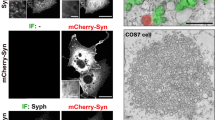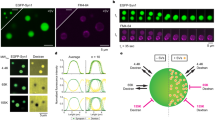Abstract
Studies on the transport kinetics and the posttranslational modification of synapsin I in mouse retinal ganglion cells were performed to obtain an insight into the possible factors involved in forming the structural and functional differences between the axon and its terminals. Synapsin I, a neuronal phosphoprotein associated with small synaptic vesicles and cytoskeletal elements at the presynaptic terminals, is thought to be involved in modulating neurotransmitter release. The state of phosphorylation of synapsin I in vitro regulates its interaction with both synaptic vesicles and cytoskeletal components, including microtubules and microfilaments. Here we present the first evidence that in the mouse retinal ganglion cells most synapsin I is transported down the axon, together with the cytomatrix proteins, at the same rate as the slow component b of axonal transport, and is phosphorylated at both the head and tail regions. In addition, our data suggest that, after synapsin I has reached the nerve endings, the relative proportions of variously phosphorylated synapsin I molecules change, and that these changes lead to a decrease in the overall content of phosphorus. These results are consistent with the hypothesis that, in vivo, the phosphorylation of synapsin I along the axon prevents the formation of a dense network that could impair organelle movement. On the other hand, the dephosphorylation of synapsin I at the nerve endings may regulate the clustering of small synaptic vesicles and modulate neurotransmitter release by controlling the availability of small synaptic vesicles for exocytosis.
Similar content being viewed by others
References
Bahler M. and Greengard P. (1987) Synapsin I bundles F-actin in a phosphorylation-dependent manner.Nature (Lond.) 326, 704–770.
Bahler M., Benfenati F., Valtorta F., Czernik A. J., and Greengard P. (1989) Characterization of synapsin I fragments produced by cystein-specific cleavage: A study of their interactions with F-actin.J. Cell Biol. 108, 1841–1849.
Baines A. J. and Bennett V. (1985) Synapsin I is a spectrin-binding protein immunologically related to erythrocyte protein 4.1.Nature (Lond.) 315, 410–413.
Baines A. J. and Bennett V. (1986) Synapsin I is a microtubule-binding protein.Nature (Lond.) 319, 145–147.
Baitinger C. and Willard M. (1987) Axonal transport of synapsin I-like proteins in rabbit retinal ganglion cells.J. Neurosci. 7, 3723–3735.
Bonner W. M. and Laskey R. J. (1974) A film detection method for tritium labelled proteins and nucleic acids in polyacrylamide gels.Eur. J. Biochem. 46, 83–88.
Cheng T. P. O., Byrd F. I., Whitaker J. N., and Wood J. G. (1980) Immunocytochemical localization of coated vesicle protein in rodent nervous system.J. Cell Biol. 86, 624–633.
De Camilli P. and Greengard P. (1986) Synapsin I: a synaptic vesicle associated neuronal phospho-protein.Biochem. Pharmacol. 35, 4349–4357.
De Camilli P., Harris S. M., Jr., Huttern W. B., and Greengard P. (1983) Synapsin I (protein I), a nerve terminal-specific phosphoprotein. II. Its specific association with synaptic vesicles demonstrated by immunocytochemistry in agarose-embedded synaptosomes.J. Cell Biol. 96, 1337–1354.
Fisher R. A. (1966)The Design of Experiments, 8th ed., Ch. IX, Sect. 56, Haffener, New York, pp. 168–171.
Garner J. A. (1979) Cohesive movement of polypeptides characteristic of a distinct component of axonal transport. Ph.D. Thesis, Department of Anatomy, Case Western Reserve University, Cleveland, OH.
Garner J. A. and Lasek R. J. (1982) Cohesive axonal transport of the slow component b complex of polypeptides.J. Neurosci. 2, 1824–1835.
Goldenring J. R., Lasher R. S., Vollano D. T., Ueda T., Stenberg N. H., Stenberg L. A., and DeLorenzo R. J. (1986) Association of synapsin I with the neuronal cytoskeleton.J. Biol. Chem. 261, 8495–8504.
Grafstein B. and Forman D. S. (1980) Intracellular transport in neurons.Physiol. Rev. 60, 1167–1283.
Hirokawa N., Sobue K., Kanda K., Harada A., and Yorifuji H. (1989) The cytoskeletal architecture of the presynaptic terminal and molecular structure of synapsin I.J. Cell Biol. 108, 111–126.
Hoffman P. N. and Lasek R. J. (1975) The slow component of axonal transport: identification of major structural polypeptides of the axon and their generality among mammalian neurons.J. Cell Biol. 66, 351–366.
Huttner W. B., DeGennaro L. J., and Greengard P. (1981) Differential phosphorylation of multiple sites in purified protein I by cyclic AMP-dependent and calcium-dependent protein kinases.J. Biol. Chem. 256, 1482–1488.
Kennedy M. B. and Greengard P. (1981) Two calcium/calmodulin-dependent protein kinases, which are highly concentrated in brain, phosphorylated protein I at distinct sites.Proc. Natl. Acad. Sci. USA 78, 1293–1297.
Laemmli U. K. (1970) Cleavage of structural proteins during the assembly of the head of bacteriophage T4.Nature 227, 680–685.
Lasek R. J. and Black M. M. (1977) How do axons stop growing? Some clues from the metabolism of the proteins in the slow component of the axonal transport, inMechanisms, Regulation and Special Functions of Protein Synthesis in Brain, Roberts S., Rajtha A., and Gispen K. H., eds., Elsevier, North-Holland, New York, pp. 161–169.
Lasek R. J. and Brady S. T. (1982) The structural hypothesis of axonal transport: Two classes of moving elements, inAxoplasmic Transport, Weiss D. G., ed., Springer-Verlag, Berlin, pp. 397–405.
Lasek R. J., Garner J., and Brady S. T. (1984) Axonal transport of the cytoplasmic matrix.J. Cell Biol. 99, 212s-221s.
Laskey R. A. and Mills A. D. (1975) Quantitative film detection of3H and14C in polyacrylamide gel fluorography.Eur. J. Biochem. 57, 335–341.
Llinas R., McGuinnes T., Leonard C. S., Sugimori M., and Greengard P. (1985) Intraterminal injection of synapsin I or calcium/calmodulin dependent kinase II alters neurotransmitter release at the squid giant synapse.Proc. Natl. Acad. Sci. USA 82, 3035–3039.
McGuinness T. L., Brady S. T., Gruner J. A., Sugimori M., Llnas R., and Greengard P. (1989) Phosphorylation-dependent inhibition by synapsin I of organelle movement in squid axoplasm.J. Neurosci. 9, 4138–4149.
O'Farrell P. H. (1975) High resolution two-dimensional electrophoresis of proteins.J. Biol. Chem. 250, 4004–4021.
Paggi P. and Lasek R. J. (1987) Axonal transport of cytoskeletal proteins in oculomotor axons and their residence times in the axon terminals.J. Neurosci. 7, 2397–2411.
Paggi P., Lasek R. J., and Katz M. J. (1989) Slow component B protein kinetics in optic nerve and tract windows.Brain Res. 504, 223–230.
Paggi P., Lasek R. J., and Katz M. J. (1990) Cytomatrix protein residence times differ significantly between the tract and the terminal segments of optic axons.Brain Res. 517, 143–150.
Pearse B. M. F. (1976) Clathrin: a unique protein associated with intracellular transfer of membrane by coated vesicles.Proc. Natl. Acad. Sci. USA 73, 1255–1259.
Petrucci T. C., Morrow J. S. (1987) Synapsin I: an actinbundling protein under phosphorylation control.J. Cell Biol. 105, 1355–1363.
Petrucci T. C. and Morrow J. S. (1991) The actin and tubulin binding domains of synapsin Ia and Ib.Biochemistry 30, 413–422.
Petrucci T. C., Macioce P., and Paggi P. (1991) Axonal transport kinetics and posttranslational modification of synapsin I in mouse retinal ganglion cells.J. Neurosci. 11, 2938–2946.
Petrucci T. C., Mooseker M. S., and Morrow J. S. (1988) A domain of synapsin I involved with actin bundling shares immunologic crossreactivity with villin.J. Cell. Biochem. 36, 25–35.
Puszkin S., Andrés A., Ores C., Lisanti M. P., and Schook W. J. (1983) Immunochemical characterization of clathrin-associated proteins (CAPs).Cell Tissue Res. 231, 495–505.
Schiebler W., Jahn R., Doucet J. P., Rothlein J., and Greengard P. (1986) Characterization of synapsin I binding to small synaptic vesicles.J. Biol. Chem. 261, 8383–8390.
Sihra T. S., Wang J. K. T., Gorelik F. S., and Greengard P. (1989) Translocation of synapsin I in response to depolarization of isolated nerve terminals.Proc. Natl. Acad. Sci. USA 86, 8108–8112.
Author information
Authors and Affiliations
Rights and permissions
About this article
Cite this article
Paggi, P., Petrucci, T.C. Neuronal compartments and axonal transport of synapsin I. Mol Neurobiol 6, 239–251 (1992). https://doi.org/10.1007/BF02780556
Issue Date:
DOI: https://doi.org/10.1007/BF02780556




